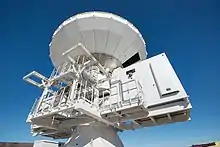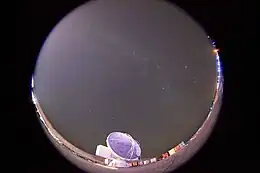Greenland Telescope
The Greenland Telescope is a radio telescope that is currently installed and operating at the Thule Air Base in north-western Greenland. It will later be deployed at the Summit Station research camp, located at the highest point of the Greenland ice sheet at an altitude of 3,210 meters (10,530 feet).
 | |
| Alternative names | GLT |
|---|---|
| Part of | Academia Sinica Institute of Astronomy and Astrophysics Smithsonian Astrophysical Observatory |
| Location(s) | Greenland. Currently located at the Thule Air Base but will be deployed at the Summit Station in the center of Greenland. |
| First light | 25 December 2017 |
| Telescope style | radio telescope |
| Diameter | 12 m (39 ft 4 in) |
| Website | www |
| | |
The telescope is an international collaboration between:
- The Academia Sinica Institute of Astronomy and Astrophysics[1] (Taiwan) (project leaders)
- The Smithsonian Astrophysical Observatory of the Center for Astrophysics | Harvard & Smithsonian (United States)
- The National Radio Astronomy Observatory (United States)
- The Haystack Observatory of the Massachusetts Institute of Technology (United States)
In 2011 the U.S. National Science Foundation gave the Smithsonian Astrophysical Observatory a 12-meter radio antenna[2] that had been used as a prototype for the ALMA project in Chile. The antenna was to be deployed in Greenland. Deploying the telescope in the middle of Greenland is ideal for detecting certain radio frequencies.
The telescope will be used to study the event horizons of black holes and to test how general relativity behaves in environments with extreme gravity.
The Greenland Telescope will become part of the global network of telescopes that makes up the Event Horizon Telescope that will study supermassive black holes and explore the origin of the relativistic jet in the active galaxy Messier 87.[3][4][5][6]
Progress and current status

Between 2013 and 2015, the Taiwanese Academia Sinica Institute of Astronomy and Astrophysics modified the telescope so that it would better work in the cold environment of the Arctic. The telescope was shipped to Greenland in July 2016 and re-assembled in July 2017 at the Thule Air Base in north-western Greenland.[7] The telescope took its first image on 25th of December 2017.
An update on "Construction, Commissioning, and Operations" of the telescope at Pituffik Space Base (the revised name for the complex) was issued on ArXiv in July 2023, describing "the lessons learned from the operations in the Arctic regions, and the prospect of the telescope." One of the less abstruse systems tested was the location system (because when the telescope is deployed to the ice cap summit, it will move with the "ground" it is mounted on. The measured location was (on Jan 23, 2018) 76°32’6.5767” N, 68°41’8.8237” W, Altitude: 89.40 m (Google maps link ; the dish was pointed towards the zenith when photographed https://goo.gl/maps/yqRpJAza8unJkZ778), to the required accuracy of 5m - a process that required about an hour of observation time. The snow and ice removal systems were also successful, working as required. While not detailing any schedule for deployment, the paper concludes that ". The GLT is ready and capable of exploiting these distinctive potentials of Greenlandic ice sheet." Ming-Tang, Chen (July 2023). "The Greenland Telescope – Construction, Commissioning, and Operations in Pituffik". arXiv:2307.10468.
The telescope will be deployed at the Summit Station research camp, located at the highest point of the Greenland ice sheet.
References
- "ASIAA - The Greenland Telescope and Submillimeter VLBI". www.asiaa.sinica.edu.tw. Retrieved 2018-03-02.
- "Greenland Telescope Project". www.cfa.harvard.edu. Retrieved 2018-01-17.
- "M87 Workshop: Towards the 100th Anniversary of the Discovery of Cosmic Jets". events.asiaa.sinica.edu.tw. Retrieved 2018-03-01.
- Asada, Keiichi; Nakamura, Masanori (2012-02-01). "The Structure of the M87 Jet: A Transition from Parabolic to Conical Streamlines". The Astrophysical Journal Letters. 745 (2): L28. arXiv:1110.1793. Bibcode:2012ApJ...745L..28A. doi:10.1088/2041-8205/745/2/L28. ISSN 0004-637X. S2CID 119241645.
- Nakamura, Masanori; Asada, Keiichi (2013-10-01). "The Parabolic Jet Structure in M87 as a Magnetohydrodynamic Nozzle". The Astrophysical Journal. 775 (2): 118. arXiv:1308.1436. Bibcode:2013ApJ...775..118N. doi:10.1088/0004-637X/775/2/118. ISSN 0004-637X. S2CID 119282302.
- Asada, Keiichi; Nakamura, Masanori; Pu, Hung-Yi (2016-12-01). "Indication of the Black Hole Powered Jet in M87 by VSOP Observations". The Astrophysical Journal. 833 (1): 56. Bibcode:2016ApJ...833...56A. doi:10.3847/1538-4357/833/1/56. ISSN 0004-637X.
- "Thule Air Base". 21 March 2013. Retrieved January 29, 2018.
Additional sources
- Hirashita, Hiroyuki; Koch, Patrick M.; Matsushita, Satoki; Takakuwa, Shigehisa; Nakamura, Masanori; Asada, Keiichi; Liu, Hauyu Baobab; Urata, Yuji; Wang, Ming-Jye; Wang, Wei-Hao; Takahashi, Satoko; Tang, Ya-Wen; Chang, Hsian-Hong; Huang, Kuiyun; Morata, Oscar; Otsuka, Masaaki; Lin, Kai-Yang; Tsai, An-Li; Lin, Yen-Ting; Srinivasan, Sundar; Martin-Cocher, Pierre; Pu, Hung-Yi; Kemper, Francisca; Patel, Nimesh; Grimes, Paul; Huang, Yau-De; Han, Chih-Chiang; Huang, Yen-Ru; Nishioka, Hiroaki; Lin, Lupin Chun-Che; Zhang, Qizhou; Keto, Eric; Burgos, Roberto; Chen, Ming-Tang; Inoue, Makoto; Ho, Paul T. P.. "First-generation science cases for ground-based terahertz telescopes". Publications of the Astronomical Society of Japan, 2016: Volume 68, Issue 1, id.R1 pp. |doi=10.1093/pasj/psv115
- The M87 Workshop: Towards the 100th Anniversary of the Discovery of Cosmic Jets
- Urata, Yuji; Huang, Kuiyun; Asada, Keiichi; Hirashita, Hiroyuki; Inoue, Makoto; Ho, Paul T. P. (2015). "A New Era of Submillimeter GRB Afterglow Follow-Ups with the Greenland Telescope". Advances in Astronomy. 2015: 165030. arXiv:1503.07594. Bibcode:2015AdAst2015E..12U. doi:10.1155/2015/165030.
- Arctic Greenland Telescope Opens New Era of Astronomy SpaceRef, 2018-05-31.